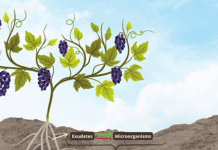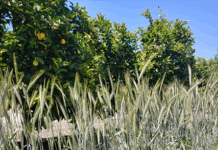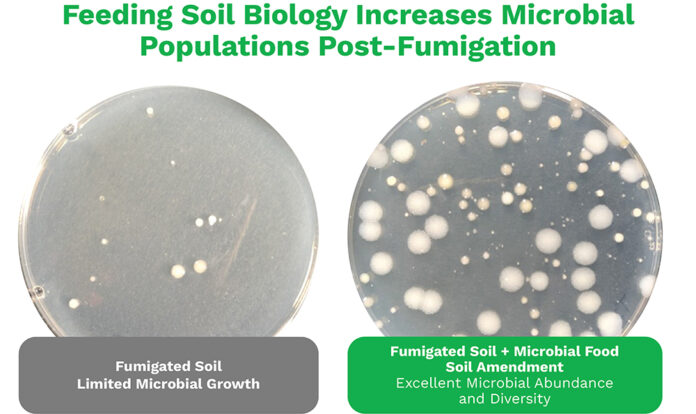
Fumigation provides a myriad of economic benefits for growers, including pest control, improved food safety and increased yields. High-value crop producers rely on fumigation to aid in the control of soilborne pests, including nematodes, fungi, bacteria and even weeds.
However, fumigants remain controversial due to potential environmental and off-target issues as well as risks to human and animal health. While both the economic and environmental benefits and risks are important to consider when fumigating, what is happening belowground? How is fumigation impacting our soil microbiome, and what are the risks and benefits to consider when considering soil health?
What Happens to Soil Microbes After Soil Fumigation?
Depending on a fumigant’s active ingredient, bacteria, fungi, nematodes and/or weeds are reduced to control pathogen load to produce a healthy crop in the following planting. Once fumigation occurs, a reduction in the target pest should be observed. However, can fumigation impact off-target organisms, or those microbes that fumigant was not intended for?
Fumigants with broad-spectrum activity can affect both target (pathogenic) and non-target (beneficial) microorganisms. This can have an impact on nutrient cycling and plant nutrient uptake, which can negatively impact soil health. The ability for beneficial, non-target organisms to recover is critical as they play an important role in the promotion of soil health. Recent studies have shown within the first four weeks post-fumigation, there is a decrease in the abundance (number) and diversity (different types) of bacteria in fumigated soils compared to untreated soils.
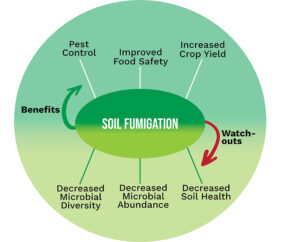
Research shows these affected microbial populations can recover in a relatively short period of time, less than a year after the application of fumigants. But what if you are regularly fumigating your fields year after year? Results have shown that the microbial communities can shift due to fumigation, meaning you may see changes in the functional diversity of these communities or what functions these microbes provide in the soil. The fumigation treatments that cause these community shifts can also contribute to physical, chemical and biological changes in the soil, ultimately degrading soil health. Long-term studies (15+ years) of repeatedly fumigated fields show non-target organisms such as arbuscular mycorrhizal fungi (AMF, which play a role in nutrient and water uptake), gram – and + bacteria, actinomycetes and fungi biomass declined compared to non-fumigated soils.
The impact on the microbial community and recovery is also dependent on the type of fumigant used, with methyl bromide having the most detrimental effects and 1,3-dicloropropene having the least. This research suggests there may be a negative impact on soil health with repeated long-term fumigation practices.
How to Rebuild Soil Microbes Following Fumigation
Avoiding fumigation all together is likely not an option for all growers. To aid in building back your microbial populations post-fumigation, utilization of soil amendments and practices can be adopted, including management practices that introduces food sources to increase microbial abundance and diversity to improve your soil and soil health (Table 1). There are many options when it comes to building soil biology and soil health. Some of these practices may have better outcomes based on your current operation.
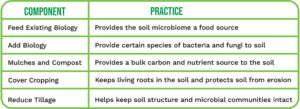
They’re Hungry! Feed Your Soil Biology
It may seem obvious that a good management choice would be to feed the post-fumigated biology in the soil, but this practice is often missed or overlooked.
After fumigation, the soil still contains fungi and bacteria, and we know that within four weeks to one year, post-fumigation populations begin to recover, and they are ready to go to work for you. The problem? They are starving and will go dormant until conditions improve. Research shows farm soils are generally low in the food sources that microbes like to eat, and this food scarcity will limit the activity of your soil biology. The answer? Give them a well-balanced meal to keep their populations up. You have many choices, including microalgae and molasses, etc. Figure 2 is an example of utilizing a microalgae food source to feed the microbes after a fumigation event has occurred. Here you can see a significant increase in microbial populations with a 6.4x increase compared to the fumigated soil alone.
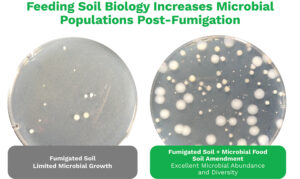
(number) and diversity (different types) when a microbial food source is applied post-fumigation.
Add Soil Biology
Another option is to add biology to the soil. There are many options when it comes to choosing the type (genus and species), but the main concept is to provide selected species of bacteria or fungi to the soil that will benefit your crop and put them to work for you. Live inoculants must stay alive to get the benefit you are looking for, which can be challenging when these sensitive microbes are exposed to changes in temperature and humidity from shipping, storage and field application. If you choose this option, plan carefully about how you are getting these products to the field, including best practices for tank mixing. Make sure your product is viable and high quality before adding to your fields.
Mulches and Compost
This practice is like the first management suggestion but provides a “slow release” food source for the microbes. Not all the carbon in plant mulch and compost is available as microbial food. Instead, it must be chemically and physically broken down before the microbes can take advantage of it. Mulches and compost provide a nutrient source to the soil. Watch out for organic matter that isn’t prepared carefully, as it can contain excess salt and weed seeds.
Reduce Tillage and Improve Your Soil Biology
Field management practices like tillage can be hard on your soil biology, particularly the soil fungi.
For example, when a disk moves through the field, it not only slices through the soil (what you want to happen) but it also slices and dices through all the fungi threads (hyphae) you are trying to grow (what you do not want to happen!). This unintentional result can have a severe impact on the biological contribution to soil structure.
Moreover, excessive tillage can compact your soil structure over time, resulting in potential water management issues. Reducing tillage can improve your soil structure on two fronts by preserving the biology and reducing the crushing and compaction of your soil structure. It’s commonly known that implementing reduced tillage may be difficult in certain operations or in more distributive soil cropping systems, so consider combining multiple practices mentioned for a beneficial alternative.
Cover Crops and Soil Biology
The use of cover crops improves soil quality and structure, builds organic matter and recycles nutrients. Cover crops can be grown in between the rows of permanent crops (e.g., trees and vines) or in the ‘off-season’ for annual crops and can be used to help feed soil microbes. Cover crop roots secrete carbon substances, called exudates, which can help boost the soil fungi and bacteria when a crop is not in the ground. Plus, their fine root hairs can tie soil particles together. Keeping soil alive year-round is key to optimizing biological contribution to soil quality.
Fumigation is a tool to help increase economic benefit for the growers including the control of soilborne pests, improve food safety and increase yield. Fumigation can negatively impact the soil microbiome, and long-term use of fumigation can reduce soil health. However, there are many options to offset any damage done to soil health by utilizing soil amendments and practices to counter the risks of declining soil health. When utilizing agricultural practices, it is best to know the long-term and short-term risks and benefits of a practice and understand how to reduce those risks with management solutions.
References
Castellano-Hinojosa, A., Boyd, N.S., Strauss, S.L. (2022). Impact of fumigants on non-target soil microorganisms: a review. Journal of Hazardous Materials, Volume 427.
Ibekwe A.M., Papiernik S.K., Gan J, Yates S.R., Yang C.H., Crowley D.E. (2001). Impact of fumigants on soil microbial communities. Appl Environ Microbiol.
Li, X., Skillman, V., Dung, J. et al. (2022). Legacy effects of fumigation on soil bacterial and fungal communities and their response to metam sodium application. Environmental Microbiome, 17, 59.
Dangi, S.R., Tirado-Corbalá, R., Gerik, J., Hanson, B.D. (2017). Effect of Long-Term Continuous Fumigation on Soil Microbial Communities. Agronomy, 7, 37.










